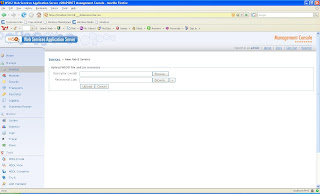Exposing an Axis1 service through WSO2 WSAS

Do you want to make use of the powerful QOS features of Axis2 with your legacy Axis1 applications? Yes it is possible with WSO2 Web services application server. It allows easy deployment of any Apache Axis1-based Web service and engage advanced WS-* services, such as WS-RM and WS-Policy in front of legacy Axis1 services. Lets see how we can use this cool feature. Step 1 Write the service impl class. package org.wso2.wsas.service; public class Calculator{ public int addition(int x, int y){ return x+y; } public int multiplication(int a, int b){ return a*b; } public int subtraction(int c, int d){ return c-d; } public double division(double m, double n){ return m/n; } } Compile and make a jar with the above class. Suppose it is Axis1resources.jar Step 2 Write the deployment descriptor (*.wsdd) for your service impl class and save it as calculator.wsdd <deployment xmlns="http://xml.apache.org/axis/wsdd/" xmlns:java="http://xml.apache.org/axis/